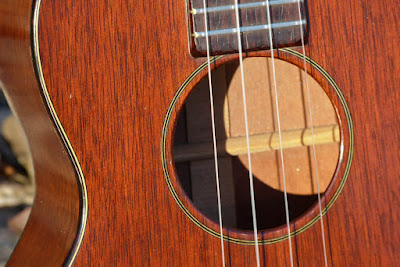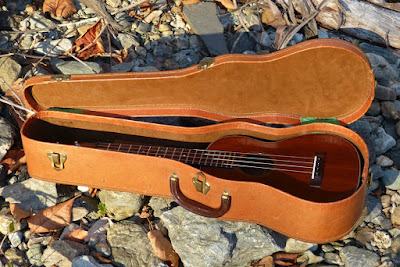1940s Martin 1T Tenor Ukulele
Update: I've added a soundclip with the high-D DGBE strings on (2nd soundclip).
Yeah, she's a pretty one, huh? Martin ukes often have to be dated by their features -- and the tortoise binding, 12 fret neck, and older-style Champion pegs (with those crumbly black buttons) that were originally on this date this one to the late 40s as far as I'm concerned. What mostly matters is that this is a classy rig.
Players who move from soprano to concert to tenor ukes (as regarding the Martin family tree) often wonder why the ukes themselves aren't apparently a whole lot louder when sitting down and strumming. The difference, however, is heard more easily on the other side of the soundhole where the long 17" scale and bigger body clearly gives more carrying power, projection, and complexity to the tone. These are excellent instruments for players who do fancy fretwork as the "body" to every note is there and it sounds full wherever you play on the neck. I can't say that's true about most sopranos even though I'm a huge soprano fan.
The tops on these are fan-braced like a classical guitar -- and just as you'd expect, that gives the top a more "guitar-like" lingering sustain and full, rounded tone with a decidedly darker-sounding (in a chocolate way) top end vs. a sparkly modern Hawaiian-style version of a tenor uke.
Work on this uke included one brace reglue, a cleat and seam reglue due to a "crunch" cluster of mini-hairline cracks on the top, a fret level/dress, installation of new Gotoh uke 4:1 geared planetary tuners, light saddle shave, and setup for spot-on 1/16" action at the 12th fret. I've strung it for standard GCEA with Martin fluorocarbon strings but do have a set of Aquila DGBE (re-entrant) strings on order and have adjusted the nut slots wider to accept gauges for that tuning as well.
Why? Well -- DGBE (high D) was what Doc Martin (and for that matter Doc Lyon & Healy) ordered for their tenor-size ukes at the time, and it's a fun alternative tuning for these as you get a thick, lower, sultry sound with it.
You have no idea how happy it makes me to see the new Gotoh pegs on this. I can't stand the old Champion friction pegs -- they tend to stick just where you don't want them to -- and these are a 1000x improvement. They also weigh less.
Aside from the pegs, the only other non-original feature are these pearl dots I added. This was missing one of the mini ivoroid dots and as no one seems to make them in the right replacement size, I decided to just swap out for slightly-larger pearl.
The board and bridge are both Brazilian rosewood, by the way, and the body and neck are both solid mahogany. I'm fairly certain the saddle is ivory and the nut is ebony. The nut width, by the way, is 1 5/16" and the neck profile is a very slim C shape which feels extremely fast.
I love the look of pin bridges on ukes.
Here's a cluster of 3 small "crunch" (ie, banged into a chair or wall) hairline cracks, the longest of which is 1" or so. I both glued all of these up and then clamped them all flush and also added a spruce cleat to the back to keep them tidy for the future. The repair turned out far better than I even hoped and it's actually really hard to see it unless you're looking.
The uke is really clean and has minor playwear/usewear here and there.
The original chip case is still functioning for light use but I had to tape up the detached hinges. Fair enough!






















Comments